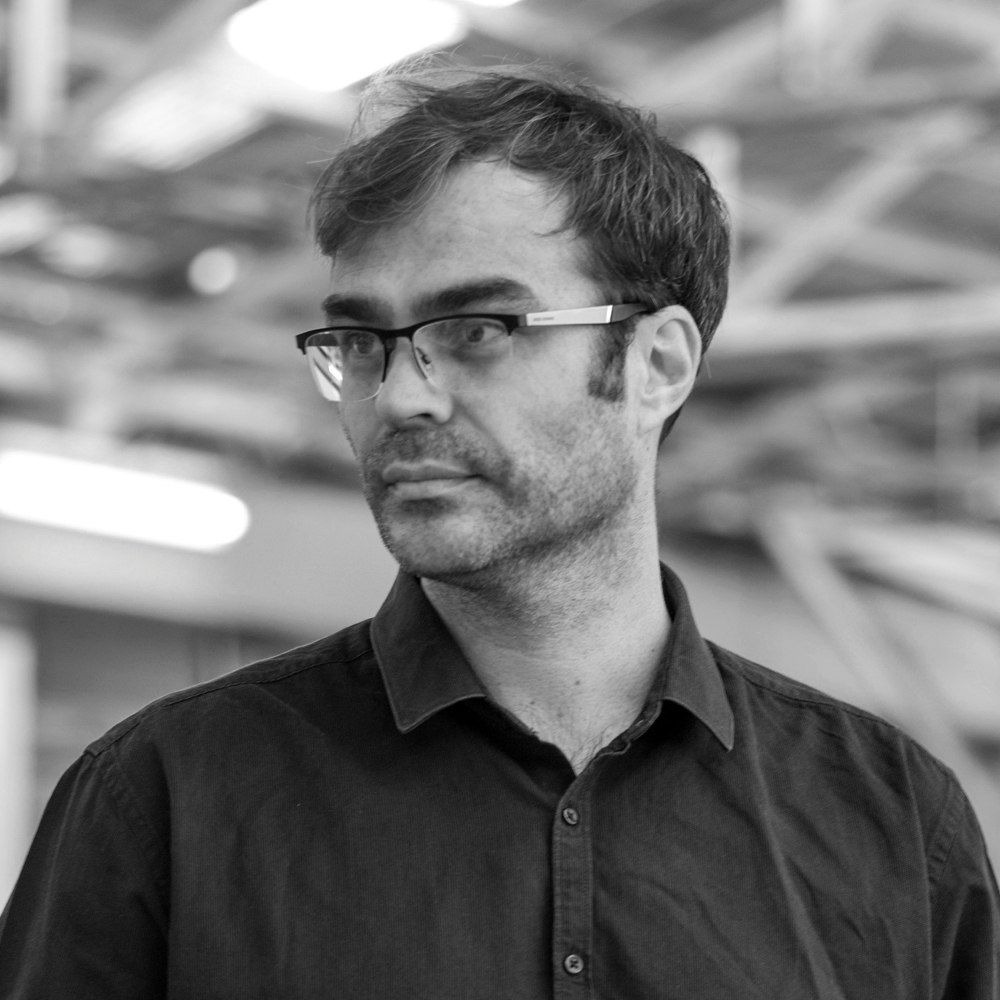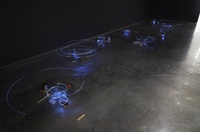Ross Manning
Brisbane
2019
Displayed 2019 at Museum of Contemporary Art Australia

Ross Manning
Born 1978, Brisbane. Lives and works Brisbane
Primarily known as a kinetic artist, Ross Manning explores light, physics, sound and the elements in his work, repurposing disused and broken electronics to create dynamic sculptures and atmospheric installations. By bringing these components into conversation with utilitarian materials such as fluorescent tubing, fans, string and brown paper, he examines our ongoing and increasingly complex relationship with technology. He breaks apart machines to demystify their rarefied position and to experiment with their material capabilities, a process that opens possibilities for sensory experience. While his work addresses technology, it also references the legacy of minimalism, sound art and expanded cinema.
Artist text
by Tim Riley Walsh
Brisbane-based artist Ross Manning’s live and experimental music performances are as varied in form and approach as his light and sound-based installations. Both also share an affinity with the overlooked and under-utilised offcuts of our increasingly electronic lives. In one such live performance, Manning assembles on a table in front of the audience an assortment of seemingly innocuous-looking odds and ends. Manning conducts these rough, outmoded objects – clock chimes, metal prongs, nails embedded in wood – by moving them into various arrangements in relation to a thread that spins across the table, connected to two pedestal fans at either end. The result is an evocative and beguiling sonic composition that belies the economy of the materials. This same approach has been replicated, too, in Manning’s installation practice, in works such as Wave Opus (2016) in particular. Manning’s artistic sensibility, a sort of ‘lo-fi sublime’, permeates much of his broader artistic practice. Eschewing high-tech illusion, he generates a peculiar magic through the barest of means.
Inside the galleries of the Museum of Contemporary Art Australia, a number of firefly-like sprites have been released. Or so our imagination might tell us. In reality, each ‘sprite’ is a light-emitting diode or LED that dangles from the ceiling, its sporadic movement encouraged by a small fan from a desktop computer. Beneath each LED, which stand in here as Manning’s surrogate performers, a small scene of assorted debris is composed: tin cans, bamboo, ceramics, metal piping, even an upturned baking tray. As the LED traverses these obstacles, the inevitable collisions reveal each item’s often-surprising acoustic character. Each cluster, consisting of the fan-powered LED and the floor-based instruments it ‘plays’, has been multiplied by Manning and scattered throughout the space to create a larger series of compositions, as well as an overarching chorus. As viewers (and listeners) we largely navigate this environment aurally. In the reduced light and with the soft hint of LEDs to guide our eyes, our conventional mechanisms for wayfinding are partially impeded.
Our experience becomes akin to echolocation: a means of spatial orientation through sound and hearing, most commonly witnessed in animals such as bats or dolphins. Echolocation is a key area of study within neuroethology (the study of animal behaviour and its control via the nervous system) and was first observed in bats by Italian biologist Lazzaro Spallanzani in 1773. It eventually came to inspire the invention of sonar, itself instigated after the sinking of the Titanic in 1912. (1) By limiting our vision, our sensitivity to the resonances emitted from Manning’s clusters and their interaction with the gallery they sit within provides a unique means of comprehending space. Moving through the gallery, our sensual experience is forced to translate: from vision to hearing and from object to space. Like Manning’s Spectra series (2012–17), which encourages diversion of the viewers’ attention from its kinetic, multicoloured fluorescent-tube construction to the complex colour-mixing that it generates on the gallery walls, this new installation reorients our aesthetic experience, de-privileging the object to empower the experiential. Newly attuned, our senses expand.
Note
(1) Alan Grinnell, ‘Early milestones in the understanding of echolocation in bats’, Journal of Comparative Physiology, vol.204, no.6, April 2018, p.519, retrieved 2 October 2018, https://doi.org/10.1007/s00359-018-1263-3.
